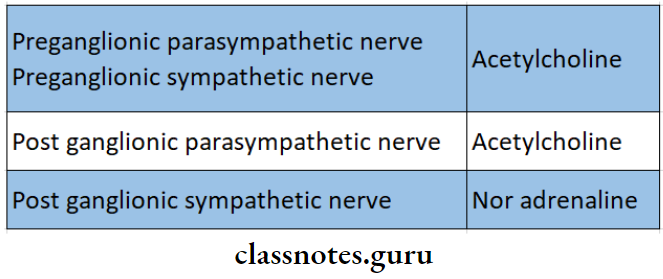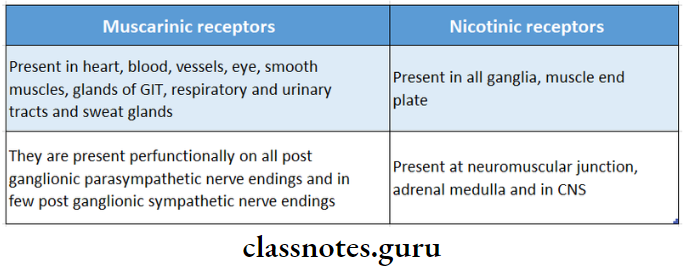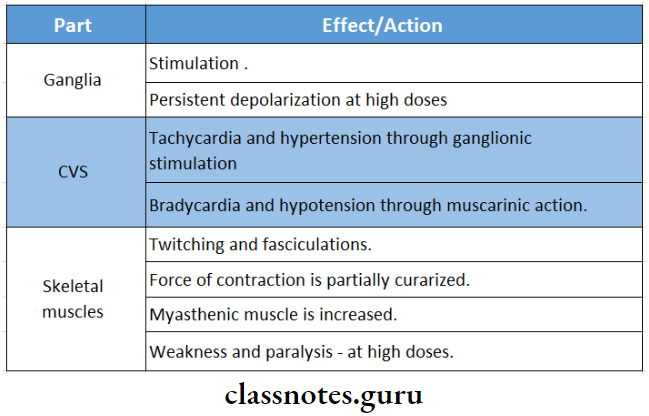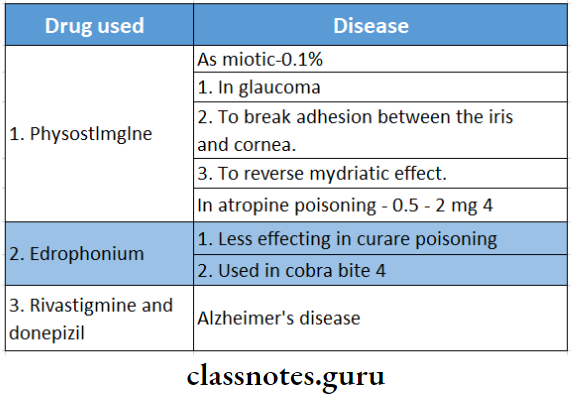Cholinergic System Important Notes
1. Divisions of the autonomic system
- The autonomic nervous system is divided into
- Sympathetic
- Parasympathetic divisions
- Sympathetic is concerned with preparing the organisms for fight and flight
- Parasympathetic is mainly concerned with the vegetative functions
- Both divisions consist of
- Preganglionic nerve
- Ganglion
- Post ganglionic nerve
- An effector organ
- Neurotransmitters released by them are

2. Cholinergic receptors

3. Actions on stimulation of acetylcholine
- Decrease in heart rate
- Increase in glandular secretion
- Contraction of smooth muscles
- Constriction of the pupil (Miosis)
- These actions are blocked by atropine
4. Cholinergic drugs
- They are also called parasympathomimetics
- They are
- Choline esters – Acetylcholine, Methacholine, Carbachol, Bethenechol
- Alkaloids – Pilocarpine, Muscarine
- Anti choiineesterases
- Reversible – Physostigmine, Neostigmine
- Irreversible – Organophosphates
Read And Learn More: Pharmacology Question and Answers
5. Drugs causing miosis
- Cholinergic drugs – Pilocarpine, physostigmine, neostigmine
- Anti adrenergic drugs – ergotamine, dibutamine
- Opioids – morphine, codeine
6. Pilocarpine
- Causes miosis, and ciliary muscle contraction and lowers intraocular pressure
- Increases secretion such as sweating, salivation
- Causes fall in BP at small doses and rise in BP at high dose
- Used only in the eye as 0.5-4% drops
7. Neostigmine
- Increases secretions
- So used in the treatment of xerostomia
Cholinergic System Long Essays
Question 1. Classify cholinergic drugs. Mention the mechanism of action, uses, and adverse effects of neostigmine.
Answer:
Cholinergic Drugs:
These drugs are those which produce action similar to that of acetylcholine, either by directly interacting with cholinergic receptors or by increasing the availability of acetylcholine at these sites.
Cholinergic Drugs Classification:
- Directly acting:
- Choline esterases. Example: Acetylcholine, bethanechol
- Alkaloids. Example: pilocarpine, muscarine.
- Indirectly – acting:
- Reversible – Example: physostigmine, neostigmine.
- Irreversible – organophosphates.
Neostigmine:
Mechanism of action:
- Neostigmine is a synthetic reversible anticholi¬nesterase agent
- It resembles the structure of acetylcholine.
- Thus it binds to acetylcholinesterases and inactivates them.
- Due to it acetylcholine (Ach) is not hydrolyzed and gets accumulated in the body.
- This produces cholinergic effects.
Pharmacological actions:
Neostigmine produces more marked effects on skeletal muscle and stimulates ganglia.

Pharmacological Uses:
- In myasthenia gravis.
- Neostigmine – 15 mg tab 6 hourly is used.
- It acts by.
- Anticholinesterase activity.
- Direct stimulation of nicotine receptors increases the amount of acetylcholine released.
- Curare poisoning.
- Neostigmine reverses the effect of muscle relaxants. It is given 0.5 – 2 mg IV.
- Postoperative paralytic ileus and urinary retention.
- Neostigmine 0.5 – 1 mg is given subcutaneously.
Pharmacological Adverse effects:
- Muscarinic effect: Salivation, lacrimation, urination, GI distress, emesis.
- Nicotinic effect: Cramps, weakness, muscle paralysis, hypertension, tachycardia, pallor, and mydriasis.
- CNS: Restlessness, headache, tremors, drowsiness, confusion, ataxia, generalized weakness, coma, convulsions.
Cholinergic System Short Essays
Question 1. Irreversible Anticholinesterases.
Answer:
Irreversible anticholinesterases are powerful inhibitors of acetylcholinesterase.
- They bind with the enzyme permanently by covalent bonds.
- They are lipid soluble and highly absorbed by all routes.
Irreversible anticholinesterases Mechanism of action:
- The structure of acetylcholinesterase contains an anionic site and an ecstatic site.
- Irreversible anticholinesterases bind only at the es¬teratic site.
- This causes the accumulation of acetylcholine in the tissues.
Irreversible anticholinesterases Drugs Included are:
- Organophosphates – floss, parathion, malathion.
- Carbamates – carbaryl, propoxur.
Irreversible anticholinesterases Use:
- Echothiophate – an organophosphate.
- Used as eyedrops in glaucoma.
- Organophosphate.
- Used in agricultural and domestic insecticides.
- Organophosphorous poisoning may be accidental, suicidal, or homicidal.
- It may lead to acute or chronic toxicity.
Organophosphorous poisoning:

Question 2. Compare neostigmine and physostigmine.
Answer:

Question 3. Therapeutic uses of reversible anticholinesterases.
Answer:
Reversible anticholinesterases include.
- Neostigmine
- Physostigmine
- Pyridostigmine
- Edrophonium.
- Rivastigmine
- Donepezil.

Cholinergic System Short Answers
Question 1. Drugs used in myasthenia gravis.
Answer:
Drugs used in myasthenia gravis are:
- Reversible anticholinesterase – neostigmine.
- Glucocorticoids.
- Immunosuppressants – Azathioprim, cyclosporine.
Question 2. Neostigmine – used in myasthenia gravis.
Answer:
Neostigmine is used in myasthenia gravis due to.
- Anticholinesterase activity.
- Binds to acetylcholinesterase and inactive them.
- Due to it acetylcholine is not hydrolyzed and gets accumulated in tissues.
- Direct stimulation of nicotinic receptors.
- This increases the amount of release of acetylcho¬line during each nerve impulse.
- Enhances acetylcholine levels at neuromuscular junctions by preventing its destruction.
- This results in an increase in the force of contraction and muscle power.
- Dose: 15 mg tab 6 hourly.
Question 3. Neostigmine – used in d-tubocurarine poisoning.
Answer:
D-tubocurarine molecules bind to nicotinic receptors and prevent the binding of acetylcholine on these receptors.
- This blocks the actions of acetylcholine.
- Thus, in curare poisoning muscle weakness occurs followed by flaccid paralysis.
- Neostigmine 0.5 – 2 mg IV given reverses the effects of muscle paralysis.
- It reverses the action of d-tubocurarine.
Question 4. Oximes in organophosphorus poisoning.
Answer:
Oximes are cholinesterase reactivators.
- They restore neuromuscular transmission in organo-phosphorous poisoning.
- They provide more reactive OH groups which react with phosphorylated enzymes to form oxime phosphonate.
- This releases the binding and sets the acetylcholi¬nesterase enzyme-free.
- They must give immediately or within a few minutes become the complex undergoes aging & then the enzyme cannot be released.
Question 5. Name a few oximes.
Answer:
- Pralidoxime
- Obidoxime
- Diacetyl; monoxime.
Question 6. Physostigmine is used in atropine poisoning.
Answer:
Atropine has the following CNS effects.
- Stimulation of medullary centers.
- Depression of vestibular excitation.
- Blockade of cholinergic overactivity.
-
- At higher doses it causes.
- Palpitation.
- Excitement, psychotic behavior, ataxia, delirium, hallucination.
- Hypotension, weak and rapid pulse.
- Respiratory depression.
- Physostigmine given 1-3 mg subcutaneously or IV antagonizes CNS and peripheral effects.
Viva Voce:
- Physostigmine is used in atropine poisoning
- Neostigmine is used in curare poisoning
- Neostigmine is used in myasthenia gravis
